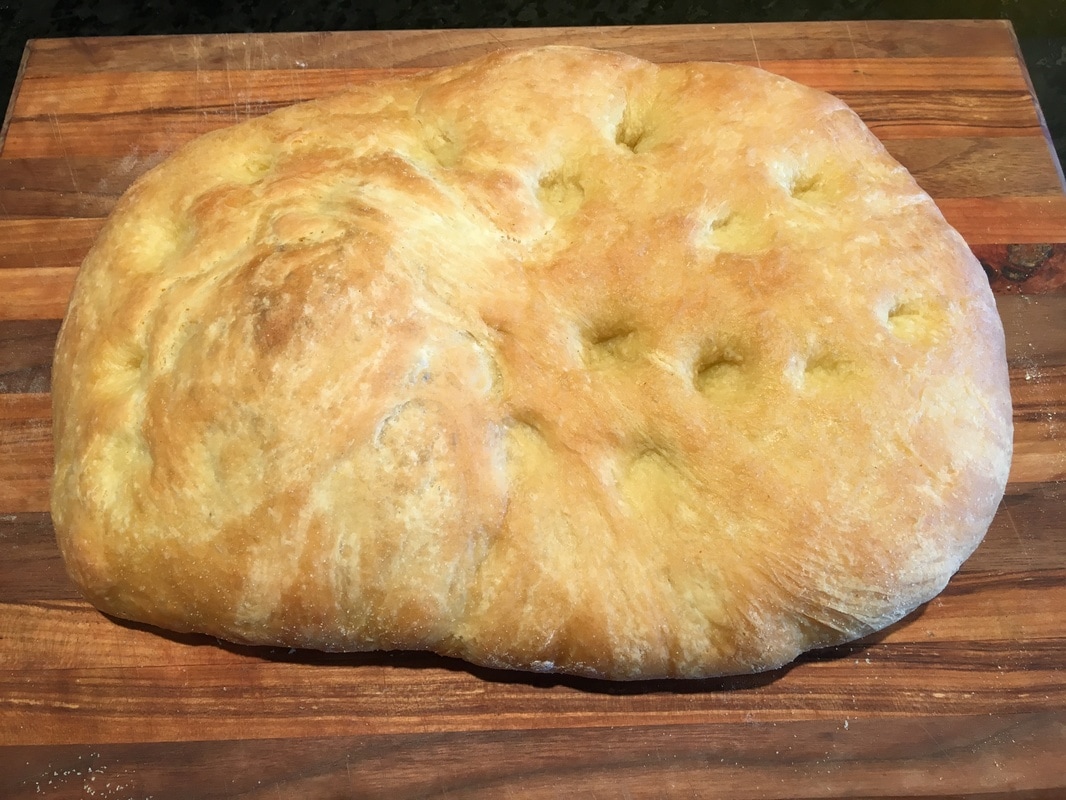| After my last blog, How Tough Can French Cooking Be? where I explicitly stated, “I have great respect for French cuisine . . .”, I was gently (and correctly) chided by several readers for seemingly drifting away from this website’s intended focus on Italian cuisine – and worse yet, drifting in the direction of France! I mention this with some concern because once again I find myself prepared to write about an Italian recipe that could have its roots in that other country. Long-term readers of these postings may recall a blog I wrote in July 2014 entitled I Hear French Food Is Good, Too. I reported that the French “have left their mark (and a French name) on every category of food imaginable, and most culinary processes – from apéritifs to digestifs, or from hors d’oeuvres to dessert (from the French word desservir).” | Focaccia di Oliva (Olive Bread). |
My good friend, former business colleague, and fellow foodie, David, reminded me that many foods are similar (if not identical) from culture to culture, but go by different names. As he wrote, “One of my favorite examples is a wrapped pastry shell containing either savory or sweet filling. In our local ‘comfort food’ restaurant here in central Texas, they offer them for dessert with such fillings as apple, cherry, blackberry, etc. These happen to be fried, but some versions are baked. Here they are called ‘fried pies’. In Spain, we had the same things, except they were called empanadas. In England, particularly in the southwest part of the country near Cornwall, they are called pasties, [and] in Natchitoches, Louisiana, they have Natchitoches Meat Pies.” In Michigan, we call them pasties!
All that made me think of other examples: Italian ravioli and Polish pierogi; Italian braciole and German rouladen; French mirepoix and Italian soffritto (or battuto); French bouillabaisse and Italian zuppa di mare; and the one that prompts all this – French fougasse and Italian focaccia!
A few months ago, I received a most appropriate eCard from my first college roommate, fellow foodie, and brother-in-law, Den. The card was appropriate because in place of the usual platitudes it contained three cleverly animated recipes – the most interesting of which was called Olive Fougasse. The recipe needed a little help (it was a greeting card, after all, not a cookbook), but the bread was delicious.
Fougasse was a new term for me, but a quick “Google” showed me that it was similar to focaccia. The big surprise came when I found the following on the Wikipedia website (that recognized bastion of all truth):
“In ancient Rome, panis focacius was a flatbread baked in the ashes of the hearth (focus in Latin). This became a diverse range of breads that include focaccia in Italian cuisine, hogaza in Spain, fogassa in Catalonia, fugàssa in Ligurian, pogača in the Balkans, pogácsa in Hungary, fougasse in Provence (originally spelled fogatza), [and] fouace or fouée in other French regions and on the Channel Islands.”
Now, who am I to argue with that logic? If this is indeed factual, this is one time when my beloved Italians were actually successful in naming something! What more can I say (write)? Nothing.
So, I will move on to tell you that my latest recipe posting is for what I am calling Focaccia di Oliva (Olive Bread). It is my version of the recipe from the greeting card (albeit electronic). It is easy, requires no special equipment, and as I’ve already mentioned, is absolutely delicious. I assure you, it’s worth a try – and it’s very Italian!
Buon appetito.
P.S. Mille grazie, David and Den.

 RSS Feed
RSS Feed